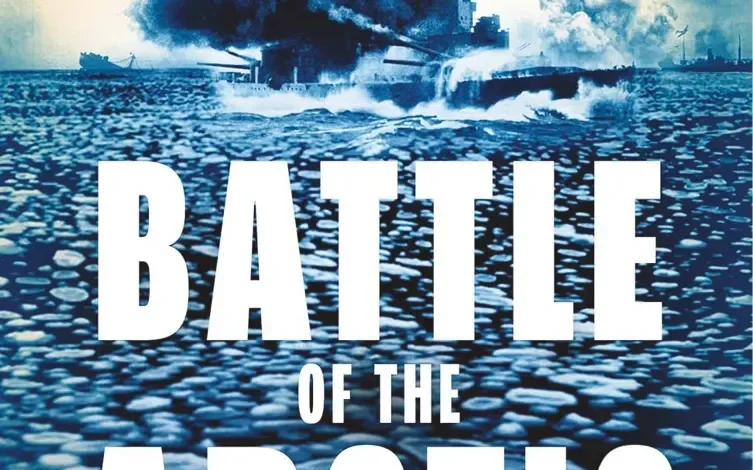Battle of the Arctic: the maritime epic of World War Two

Subscribe now for full access and no adverts
REVIEW BY NICK HEWITT
Developing a fresh interpretation for a well-charted subject area is always a challenge, as this reviewer knows only too well. I therefore approached Hugh Sebag-Montefiore’s reconsideration of the naval campaign fought to sustain the Soviet Union via the perilous northern convoy route between 1941 and 1945 with some trepidation, having spent some years as resident historian aboard HMS Belfast, which operated in the Arctic for over a year, and having read almost every existing English-language book on the subject as a consequence.
It is with some relief, therefore, to be able to open this review by saying that the author has succeeded in his aim of bringing a fresh perspective to this very well-established topic. His approach, clearly laid out in the introduction, has been to avoid going over old ground by attempting to relate every single convoy and incident in what was a very long campaign, and instead to focus on a series of key incidents, devoting one or more chapters to them, but then filling in the gaps between with the briefest of linking text.
Through this approach, his intention is to avoid the pitfalls of previous writers, who, the author says, have only been able to include everything by ‘judicious abridgment, in the course of which many of the most dramatic experiences have been summarised in a few paragraphs.’ Battle of the Arctic is unequivocally an account of the experience of the Arctic Convoys and not a detailed analysis of the political, economic, or grand strategic context, which the author confines himself to sketching out as briefly as possible, and only when absolutely essential. Sebag-Montefiore gives appropriately generous credit to those who have gone before, and in particular to the late Richard Woodman, whose Arctic Convoys 1941-1945 will always be the definitive account for this reviewer.
Like its predecessors, Battle of the Arctic is a chronological account beginning with the very first convoy to Russia, Operation Dervish, in August 1941, and concluding with the final wartime convoys in March and April 1945. Some of the ground is very well trodden indeed, notably the destruction of convoy PQ-17 in June-July 1942, to which Sebag-Montefiore devotes eight chapters, and his exceptionally dramatic account of the Battle of the Barents Sea in December 1942, which includes revealing insights into the loss of HMS Achates and HMS Bramble. There is always something new to discover in a book that refreshingly draws on numerous official and unofficial primary sources, including less frequently consulted Norwegian, Russian, German, and American material, in addition to more familiar British accounts and well-known memoirs and secondary works. Of particular interest are the significant number of German unit war diaries (Kriegstagebücher, or KTB) consulted, and the author’s use of a private Norwegian archive, Acta Novegica Arkiv, which contains a wealth of German, English, and US documents, including more KTB and microfilm copies of US merchant marine records from the National Archives in Washington, DC.
Gruelling conditions
One of the author’s strengths is his determination to continue to relate the often-muted narratives of sailors once their ship has vanished and they have fallen well behind the comforting umbrella of their convoy and its naval escort. The experience of being shipwrecked and spending hours or days in a lifeboat is always gruelling, but never more so than in the extreme environmental conditions of the Arctic, and the author has made a great contribution to the historiography by allowing the voices of these individuals – interestingly, not all are men – to be heard. Of particular note are the gripping but harrowing accounts of the survivors from two independently sailing merchant ships that were unwisely dispatched from Iceland as part of the misconceived and disastrous Operation FB at the end of 1942, following political pressure to resume supplies to the Soviet Union after the destruction of PQ-17. A handful of British survivors from the SS Chulmleigh survived for seven months on Svalbard before being rescued by Norwegian ski troops, and the last three survivors from the Soviet freighter Dekabrist were not finally ‘rescued’ – the term is debatable, as they were picked up by a U-boat and became prisoners of the Germans – from the remote and unfortunately named Hope Island until October 1943, 11 months after their ship had been sunk. The handful of ships that sailed independently in Operation FB rarely warrant more than a footnote in most accounts of the Arctic Convoys, as their strategic impact was almost non-existent, so it is refreshing to see their stories told in such detail.
Being shipwrecked is always gruelling, but never more so than in the Arctic.
Convoy PQ-17 forming off the west coast of Iceland in late June 1942. Image: photographed by Ensign Howard Carraway © Naval History and Heritage Command
Of similar merit are the author’s descriptions of the very challenging conditions experienced by Allied sailors on arrival in the Soviet Union, where the ‘hospitality’ they experienced ranged from being merely shunned by the locals, to arbitrary violence or arrest. The attention given by the author to the very limited medical care available to survivors once they were brought ashore in the Soviet Union is of particular interest. The dreadful Soviet hospitals, which struggled to function in isolated and starving communities, and the long, frustrating campaign to have a properly equipped British medical facility brought to the Kola Inlet, are not exactly a secret. However, the subject rarely receives more than a cursory mention in most books, and certainly the full horror of the ‘treatment’ provided was largely new information for this reviewer. PQ-17 survivor Ronnie Crees’ account, from the remarkable sound archives of the Imperial War Museum, makes for particularly grim reading: ‘[They] sat us on the table with our legs out in front of us… we could see the scissors come out. And there’d be snip, snip. And something would fall into a bucket… when the first chap came back, we learned that he’d lost two toes.’ But by far the most traumatic description comes from Morris Mills of the freighter New Westminster City, who was seriously wounded when the ship was bombed in Murmansk, having arrived as part of PQ-13 in March 1942. Mills’ badly damaged left foot was amputated, and the stump eventually became gangrenous; when his foul paper dressing was removed some time later, nurses touched an exposed nerve, resulting in his leg involuntarily twitching and scattering an array of instruments. This in turn brought over an enraged Red Army doctor, who pointed a pistol in his face while screaming at him in Russian.
New narratives
The role of the Soviet Union itself in these operations is another largely overlooked narrative in Western literature, as is the naval history of the USSR more generally. The book is peppered with fascinating vignettes drawn from Russian sources, which really add a new dimension to traditional Arctic narratives. It was particularly interesting to read Chapter 40, dubbed ‘The Soviet Union’s PQ-17’, which describes events in the White Sea in August 1944, and specifically a U-boat attack on the Soviet convoy BD-5, drawing entirely on German and Soviet sources.
Battle of the Arctic is lavishly illustrated, with 24 excellent and very detailed maps, and no fewer than 116 photographs drawn from a wide range of sources, many of which are rarely if ever reproduced in published works.
There are inevitably some small gripes. Although the writer’s style is generally gripping, there are a number of clunky literary tics that could be removed to the immense benefit of the narrative flow. The author’s use of the term ‘HMS ships’ as shorthand for Royal Navy or naval ships is grating; it is never used in works of naval history, as spelt out in full it would read ‘His Majesty’s Ship ships’. It also feels unnecessary to explain every time a ship’s gun turret is referenced that (for example) B turret is ‘the one behind the forwardmost turret’, or for every merchant ship’s convoy number to be first referenced (for example, 13) and then explained as ‘the first column on the extreme left of the convoy, and row 3 i.e. the 3rd row from the area of sea in front of the convoy’. These technical points are already explained in the ‘Notes for Readers’ at the beginning, and it is the opinion of this reviewer that this is where they should stay, accompanied, if necessary, by a simple diagram – individual plans for several of the most important convoys are in fact supplied in a useful appendix.
These are minor concerns. Overall, Battle of the Arctic is an excellent addition to the literature surrounding the Arctic Convoys. The book is written in an engaging and accessible style, with plenty to offer the general reader, for whom it would be an excellent introduction to the subject. For the specialist, it contains a great deal of new research that adds significantly to our understanding of the subject, and is highly recommended.
Battle of the Arctic: the maritime epic of World War Two
Hugh Sebag-Montefiore
William Collins, hbk, 816pp (£30)
ISBN 978-0008335779





